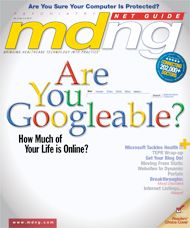5 Questions... with Gary Kennedy, President and Chief Executive Officer, RemedyMD
The beat on the people, devices and companies shaping healthcare.
1
Are physicians finally ready to embrace the EHR?
It’s a gradual thing, although from our perspective, it’s picking up. The issue has been that physicians look at EHRs and see a one-size-fits-all product; they say “this doesn’t meet any of my needs. I don’t want to practice medicine as a cardiologist the same way an orthopedic surgeon does.” Our approach has been that nobody’s going to buy an EHR unless it’s specialty-specific.
2 A RemedyMD press release claims that “the healthcare industry is severely restricted by siloed medical data that does not provide a holistic view of patients’ health.” What do you mean by that?
Right now, the data people have access to is typically one-dimensional. If you’re seeing a doctor, if you’re lucky, you’ll have the record of your previous visits. But you don’t have visits to other doctors or hospitals. We take a 360-degree view of the patient, aggregating 10 dimensions of data so we really can get a holistic view and recognize patterns. For our patients, we have specialty-specific information and hospital information. We track research data, and we add that to a patient’s profile. If a patient’s characteristics place them as part of a research project cohort, we track that cohort. That turns out to be very enlightening, because we try to extrapolate what other characteristics of the cohort apply to them. Then, we start adding metabolic, genotypic, proteomic, microarray, claims, and heredity data. Once you aggregate all of those in the product we call Mosaic, patterns begin to emerge.
3 RemedyMD’s SMART Platform has built-in features that enable payers and others to track outcomes; is this going to be a key part of all EHR technology as we move into the era of P4P?
A better description for pay-forperformance would be pay-for-compliance with specified procedures, because very few people can measure performance, so they measure compliance. That’s a first step, but the next step is measuring outcomes, and then infl uencing outcomes. What we’ve built is the decision-support engine that uses all this data we collect and helps provide the information to make decisions. Our theory is that better decisions inexorably lead to better outcomes. I think the idea of pay-for-performance without decision support is not going to get anywhere.
4 Why did RemedyMD decide on a Web-based EHR, rather than a system that relies on local servers?
The benefits of being able to have on-demand, anytime access, backed up without having to pay attention or having to buy or upgrade the hardware or hire a network administrator—you just plug it in and go—are compelling. In fact, we have several partners who are actively working with us to Web-enable their existing systems. What they found is that they could actually rebuild their practice management applications using our platform (SMART) for less money than they can Web-enable their old applications.
5 Where does the patient fit into everything you’ve discussed?
We created a patient portal called My Health Manager, not knowing how many patients would use it; we have about 170,000 who have. Many of those are using it daily to journal their habits. The only way to really monitor outcomes, unless you want to have a doctor who practically calls the patients every day, is to have patients be able to record outcomes. In other words, it’s not important whether they fill the prescription. It’s not even important whether the doctor wrote the right prescription. What’s important is whether the patient takes the prescription and how they feel after a week or two or six. And everything we built is tethered, so the doctor can log on every day to the patient’s record to see trends and discuss them with the patient.
It’s also important from a decision-support standpoint. We want to be able to recommend an intervention when a patient is still doing pretty well but we’ve recognized a pattern. If we can intervene early, then the benefits to the system are dramatic. Too many people are focused on transferring costs. The only real way to wring costs out of the system is to be able to dramatically improve and influence outcomes. If the healthcare industry had the decision-support and pattern recognition architecture that exists in Wall Street today, it would solve the entire healthcare costs problem. The whole basis for arbitrage is pattern recognition, and proactively taking actions before things happen. That’s the quest we’re after.
